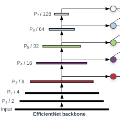Airway segmentation in computed tomography images can be used to analyze pulmonary diseases, however, manual segmentation is labor intensive and relies on expert knowledge. This manuscript details our contribution to MICCAI's 2022 Airway Tree Modelling challenge, a competition of fully automated methods for airway segmentation. We employed a previously developed deep learning architecture based on a modified EfficientDet (MEDSeg), training from scratch for binary airway segmentation using the provided annotations. Our method achieved 90.72 Dice in internal validation, 95.52 Dice on external validation, and 93.49 Dice in the final test phase, while not being specifically designed or tuned for airway segmentation. Open source code and a pip package for predictions with our model and trained weights are in https://github.com/MICLab-Unicamp/medseg.
翻译:计算透视图象中的空气分割可被用于分析肺病,然而,人工分割是劳动密集型的,依赖专家知识。本稿详细说明了我们对MICCAI2022年空气树建模挑战的贡献,这是一个完全自动化的空气路分割方法的竞争。我们采用了以前开发的深层学习结构,其基础是经修改的高效设计(MEDSeg),利用提供的注释进行双向空气分割培训。我们的方法在内部验证中达到了90.72骰子,在外部验证中达到了95.52骰子,在最后测试阶段达到了93.49骰子,但没有为空气路分割专门设计或调整。我们模型和经过培训的重量预测的开放源码和套件载于https://github.com/MICLab-Unicamp/medseg。




